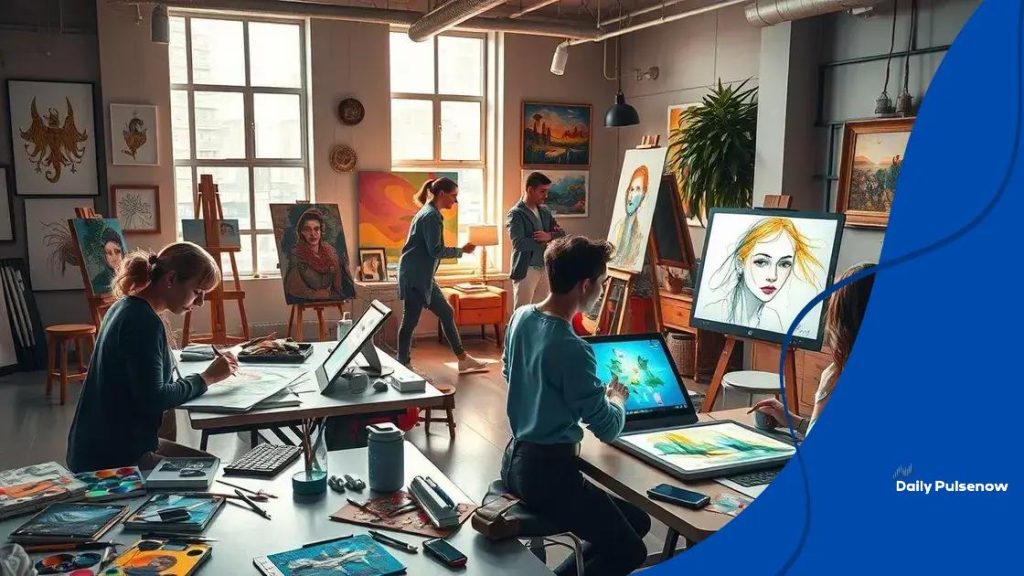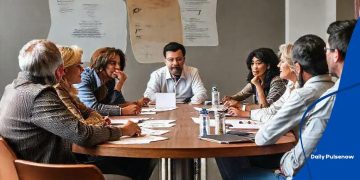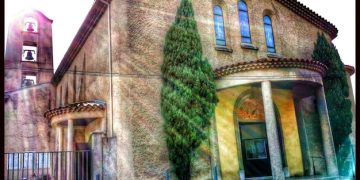The rise of AI-generated art: exploring creativity and copyright

Anúncios
The rise of AI-generated art transforms creativity by merging technology with traditional practices, raising important questions about copyright, originality, and the future of artistic expression.
The rise of AI-generated art raises fascinating questions about creativity and ownership. As technology evolves, how do we define originality in creative works? Let’s delve into this thought-provoking topic.
Anúncios
Understanding AI-generated art
Understanding AI-generated art is essential in today’s digital age. As technology advances, artists and creators grapple with the implications of using artificial intelligence in their work. AI-generated art is not just a passing trend; it blends creativity and algorithms, creating unique pieces that challenge traditional notions of artistry.
The power of algorithms
At the heart of AI art creation are complex algorithms. These algorithms analyze vast datasets, learning styles and techniques from numerous sources. This learning process enables AI to generate pieces that reflect various artistic influences.
- AI can mimic styles of famous artists.
- Algorithms can identify patterns in color, form, and composition.
- AI tools can help artists explore new creative avenues.
- Some AI programs allow for user input to guide the creation process.
With the ability to produce artwork quickly, AI assists artists in experimenting with different concepts. This rapid generation allows creators to focus more on refining their ideas rather than starting from scratch every time. Yet, with these benefits come questions about originality and authorship.
Anúncios
Artistic collaboration between humans and AI
As artists utilize AI tools, the lines between human creativity and machine-generated art blur. For many, AI serves as a collaborator rather than a replacement. Artists can provide direction, ensuring the output aligns with their vision while benefiting from the speed and variety AI offers. The collaboration can foster innovation and unique expressions, melding human intuition with computational prowess.
Many creators report that working with AI has led them to discover new techniques and perspectives they might not have explored otherwise. This dynamic relationship promotes a dialogue where technology enhances creativity rather than stifling it.
Ethical considerations in AI art
As the use of AI-generated art rises, various ethical dilemmas emerge. Questions surrounding copyright, ownership, and authenticity arise. Who owns the rights to an artwork created by an AI? Is it the programmer, the user, or the AI itself? These questions prompt discussions about the nature of creativity and the value of human input.
- Recognizing the contribution of AI in artwork.
- Understanding the implications for traditional artists.
- Debating the originality of AI-generated pieces.
Such debates are crucial as creators navigate this new landscape. By examining these ethical concerns, artists and stakeholders can develop frameworks that respect and protect the interests of all involved.
The impact on traditional creativity
The impact on traditional creativity is significant as AI technologies transform the artistic landscape. Many traditional artists find themselves re-evaluating their processes as these new tools emerge. The integration of AI into the creative process has both challenged and expanded the boundaries of what art can be.
A new canvas for artists
For many artists, AI serves as a new canvas. By harnessing the capabilities of algorithms, they can experiment with styles, forms, and concepts that may not have been possible before. This technological shift creates opportunities for artists to push their creative limits.
- AI can generate countless variations of a single piece.
- Artists are able to collaborate with AI, creating hybrid works.
- Access to AI tools democratizes art-making.
- Innovative artworks can inspire new genres.
While some might view AI as a threat to traditional practices, it often enhances creativity. By automating routine tasks, artists can focus more on ideation and expression. This shift allows for a more playful approach to art-making.
Challenging the definition of art
The emergence of AI-generated art prompts a reevaluation of what it means to be an artist. As machines create pieces that rival human craftsmanship, discussions around authenticity and talent arise. Some argue that creativity is inherently human, while others see AI’s role as a crucial part of the modern art movement.
These debates highlight the evolving nature of art in the digital age. Artists must adapt to these changes, embracing AI as a partner in their creative journey. By doing so, they can redefine their artistic practices and explore new avenues for expression.
Embracing collaboration
Collaboration between humans and machines is becoming increasingly common. Many artists are finding success by combining their intuition with AI’s capabilities. This synergy opens doors to unprecedented artistic experiences that blend technology with human emotion.
- Collaborative efforts can yield unique artistic styles.
- New methods allow for rapid prototyping of ideas.
- Artists gain insights from AI’s data analysis.
As artists continue to engage with AI, they create a landscape rich with possibilities. The impact on traditional creativity is profound, urging artists to explore and innovate.
Copyright challenges in the digital age

Copyright challenges in the digital age have become increasingly complex, especially in the realm of AI-generated art. As artists create with the help of AI, the question of ownership and originality arises.
The nature of copyright
Copyright is designed to protect the rights of creators, giving them control over the use of their work. However, with AI systems capable of generating art, the idea of copyright becomes murky. Who is the rightful owner of an artwork created by an AI? Is it the programmer, the user, or the AI itself?
- AI can replicate the styles of existing artists.
- Originality is increasingly challenging to define.
- Existing laws may not cover AI-generated works.
- There is a need for updated legal frameworks.
Navigating these challenges requires a deep understanding of both artistic practices and legal implications. Many artists are finding themselves in uncertain territory regarding the ownership of their creations as they use AI tools.
Fair use considerations
Another major factor in copyright challenges is the concept of fair use. This legal doctrine allows limited use of copyrighted materials without permission under certain conditions. As AI-generated art often draws from vast databases of images and styles, the line between fair use and infringement can become blurred.
Artists must consider how their work interacts with existing copyrights. For example, if an AI generates a piece inspired by a well-known artist, questions about the legality of using that inspiration arise. Understanding fair use is essential for navigating these waters.
Emerging solutions
To address these challenges, various solutions are emerging. Some propose new definitions of authorship that include AI as a co-creator. Others advocate for legal reforms that specifically tackle the unique aspects of AI-generated works.
- Creating a registry for AI-generated art.
- Developing guidelines for fair use regarding AI.
- Encouraging collaboration between artists and legal experts.
These solutions aim to establish clearer boundaries, allowing artists to innovate while protecting their rights. As the digital landscape evolves, ongoing discussions about copyright will be crucial for the future of art.
Case studies of AI art
Case studies of AI art illustrate how artificial intelligence is transforming the artistic landscape across various mediums. These examples offer insights into the creative potential of AI and the diverse ways artists are integrating these technologies into their works.
The work of Refik Anadol
Refik Anadol is a pioneer in the field of AI-generated art. His projects utilize data to create stunning visual experiences. For example, his piece titled *Melting Memories* uses data from the human brain to produce a dynamic audiovisual installation. This blend of technology and art challenges the boundaries of traditional artwork.
- His work explores the relationship between memory and visual art.
- Data-driven projects invite viewers to engage in new ways.
- Use of AI reflects contemporary themes in art.
Through his installations, Anadol raises important questions about perception and emotional responses to art. His works highlight how AI can transform static experiences into vibrant, evolving narratives.
AI and the fashion industry
AI is also making waves in the fashion industry. Brands like Balenciaga have collaborated with AI designers to create unique clothing lines. These collaborations allow for the rapid generation of designs that would be impossible to achieve manually.
Fashion designers using AI can produce a wide range of styles in a short time, allowing for greater experimentation. This integration showcases how technology can influence traditional artistry and drive innovation.
The AI-generated painting “Edmond de Belamy”
One landmark case in AI art is the portrait *Edmond de Belamy*, created by the Paris-based art collective Obvious. This portrait is generated using a machine-learning algorithm trained on a dataset of historical portraits. It sold at auction for over $432,000, sparking debates about authorship and value in the art market.
- This case raises questions about who holds rights to AI-generated works.
- It challenges the art market’s traditional definitions of originality.
- Discussions focus on the role of the artist versus the machine.
Such case studies emphasize the need for ongoing dialogue regarding the implications of AI in art. As these instances show, the intersection of technology and creativity opens up new avenues for exploration.
Future trends in art and technology
Future trends in art and technology indicate a significant shift in how we perceive and create art. As technology continues to evolve, artists are presented with new tools and platforms to express their creativity. The merging of art and technology is on the verge of transforming the entire art scene.
Increased use of immersive experiences
One trend to watch is the rise of immersive art experiences. Technologies like virtual reality (VR) and augmented reality (AR) allow audiences to engage with art in ways that were previously unimaginable. For instance, viewers can step inside a painting or interact with digital sculptures.
- Immersive experiences create deeper emotional connections.
- VR and AR can offer educational content alongside art.
- Artists can reach wider audiences through virtual exhibitions.
This approach not only enhances viewer engagement but also encourages new forms of storytelling. Artists will increasingly experiment with these technologies to offer unique narratives and experiences.
AI as a creative partner
Another key trend is the continued integration of AI as a creative partner. Algorithms will enable artists to explore imaginative possibilities and produce works that combine human creativity with machine learning. AI tools can assist in brainstorming, generating ideas, and even completing complex tasks.
This collaboration can lead to innovative outcomes and redefine artistic processes. As artists experiment more with AI, the boundaries of creativity will expand, allowing for the emergence of entirely new art forms.
Sustainability in art practices
Sustainability is also becoming a major focus in the art world. Artists increasingly seek eco-friendly materials and methods to create their work. This trend reflects a broader societal movement toward environmental awareness and responsibility. By embracing sustainable practices, artists can reduce their carbon footprint while creating impactful art.
- Using recycled materials can enhance the artistic message.
- Digital art can minimize physical waste.
- Artists are raising awareness through eco-themed projects.
By combining technology and sustainability, artists can push their creative boundaries while contributing positively to the world.
FAQ – Frequently Asked Questions about AI-generated Art
How does AI influence traditional art practices?
AI offers new tools and methods that can enhance creativity, challenge traditional practices, and allow artists to express their ideas in innovative ways.
What are the copyright implications of AI-generated art?
Copyright issues arise regarding ownership and originality, as it can be unclear who holds the rights to artworks created by AI systems.
Can AI art be considered ‘real’ art?
Many argue that AI-generated art is legitimate as it involves human creativity in directing the AI, thus it can evoke emotions and meanings like traditional art.
What trends are shaping the future of art and technology?
Key trends include immersive experiences, increased collaboration between artists and AI, and a growing focus on sustainability in artistic practices.





